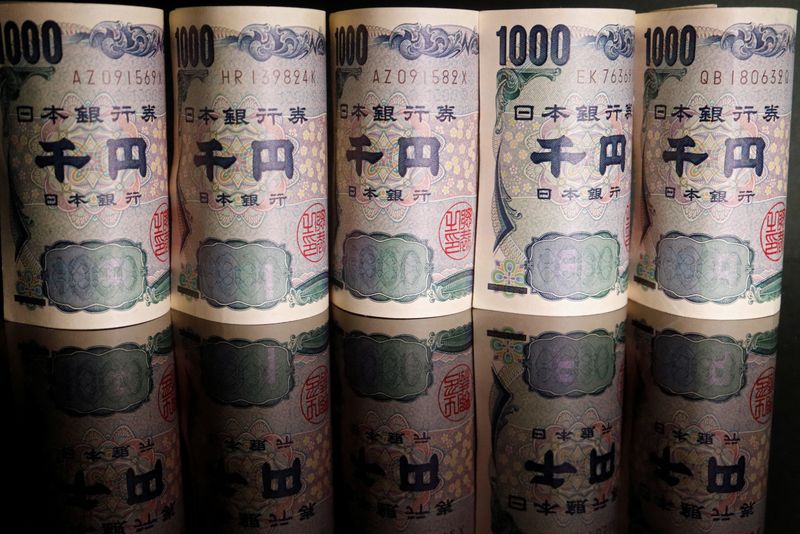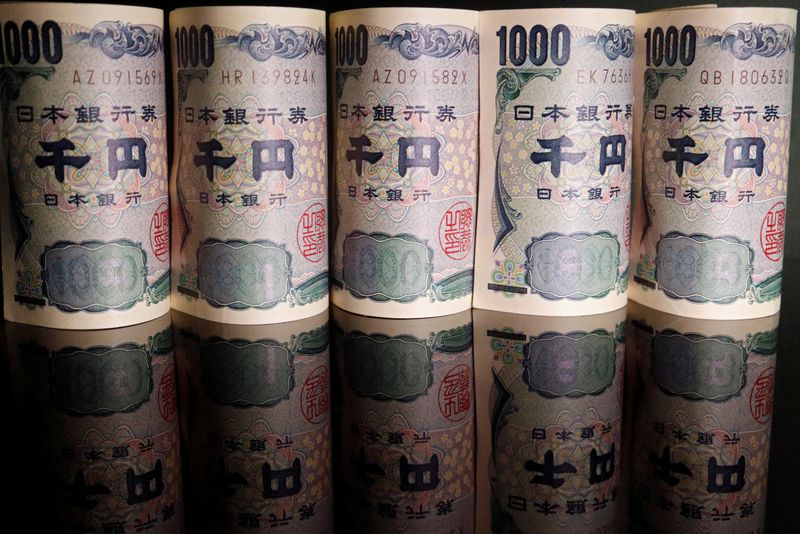Forex
Analysis-Japan’s policymakers hold fire as yen enters intervention range


© Reuters. FILE PHOTO: Banknotes of Japanese yen are seen in this illustration picture taken September 23, 2022. REUTERS/Florence Lo/Illustration
By Kevin Buckland
TOKYO (Reuters) – As the yen slid past 145 per dollar with barely a murmur from Japanese policymakers during recent days, suspicion grew that they won’t be as quick to order intervention as they were last year as they now reap some benefits from a weaker currency.
Surging exports helped economic growth hit 6% on an annualised basis in the second quarter, and lower global oil prices have helped keep a lid on the import bill.
But a key factor behind the yen’s weakness is unchanged, namely the yawning yield gap with the United States. The Bank of Japan is taking baby steps away from its ultra-loose monetary policy, and there are increasing hopes that U.S. rates may have peaked, but as of now, the bond market provides a good reason to sell yen.
Yet currency traders remain nervous about provoking intervention, as the yen entered the same zone that triggered heavy dollar selling by Japanese authorities in September and October of last year.
Finance Minister Shunichi Suzuki issued a reminder on Tuesday against causing volatility in the exchange rate, as the
yen struck a 9/1-2 month low of 145.60 in Asian trading.
Suzuki warned that rapid moves are “undesirable” and the government is “ready to respond appropriately,” while reiterating that no specific levels are targeted for intervention.
Officials had been a lot more vociferous in June when the yen weakened past 144, and their subdued response to the latest depreciation was interpreted by market participants as a sign that Tokyo will tolerate a bit more weakness so long as speculators didn’t push it too fast.
“The pain associated with the 145-150 level is less now for the economy, so I don’t think they’ll be quite as aggressive as they were last year,” said Aaron Hurd, a senior portfolio manager at State Street (NYSE:) Global Advisors in Boston.
If the uptrend for the dollar-yen rate is gradual, intervention isn’t likely until “around 150 or a little bit above,” he said.
For now, traders are testing the waters by selling the yen against sterling and the Swiss franc, mindful that selling against the dollar could gather momentum quickly.
NO IMPERATIVE TILL 150
Japan spent more than 9 trillion yen ($62 billion) intervening in currency markets last year to arrest the yen’s decline, buying yen in September and October – first at levels around 145 and again at a 32-year low just short of 152.
At the end of August last year, the price of was about $105 per barrel, and complaints about the pain from imported energy prices were in the Japanese press on a daily basis.
“Not only economically, but also politically, yen weakness at that time was a problem, and it clearly impacted the government’s approval rating,” said Masayuki Kichikawa, chief macro strategist at Sumitomo Mitsui (NYSE:) DS Asset Management in Tokyo.
The price of Brent is now around $88, and those complaints over imported fuel have faded into memory.
From a purely macroeconomic perspective, Kichikawa said, officials have no imperative to prevent yen weakness before 150, which is consistent with the mild inflationary pressure that the BOJ aims to foster.
The bond market, which precipitated the yen’s slide, may ultimately give Japan’s authorities reason to hold off on pressing the intervention button.
Should the lynchpin stabilise not far above 4%, and Japanese yields rise towards the BOJ’s new 1% cap, Japanese authorities may be inclined to let market forces perform a gradual recovery in the yen as the yield gap closes.
“The policy divergence story is going to turn, if it hasn’t already,” said Shinichiro Kadota, a currency strategist at Barclays (LON:) in Tokyo. “The risk of intervention definitely increases above 145, but the urgency is less.”
($1 = 145.4900 yen)

 Forex3 years ago
Forex3 years agoForex Today: the dollar is gaining strength amid gloomy sentiment at the start of the Fed’s week

 Forex3 years ago
Forex3 years agoUnbiased review of Pocket Option broker

 Forex3 years ago
Forex3 years agoDollar to pound sterling exchange rate today: Pound plummeted to its lowest since 1985

 Forex3 years ago
Forex3 years agoHow is the Australian dollar doing today?

 Cryptocurrency3 years ago
Cryptocurrency3 years agoWhat happened in the crypto market – current events today

 World3 years ago
World3 years agoWhy are modern video games an art form?

 Commodities3 years ago
Commodities3 years agoCopper continues to fall in price on expectations of lower demand in China

 Economy3 years ago
Economy3 years agoCrude oil tankers double in price due to EU anti-Russian sanctions





















